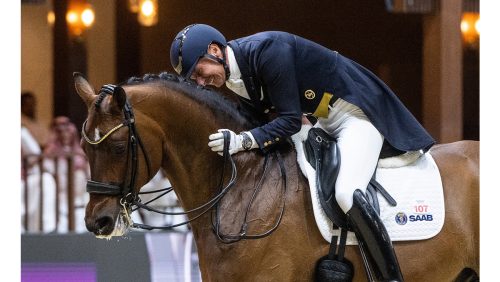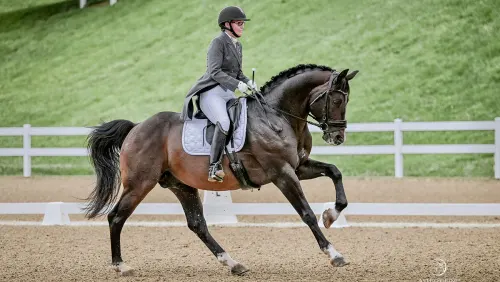In this series, the Chronicle follows seven riders as they seek to fulfill their Olympic dreams in London in 2012.
Things have been going really well. I’m feeling much more comfortable, which makes a big difference in everything I do. [Brueckmann, who suffers from reflex sympathetic dystrophy, underwent a voluntary leg amputation in November to make herself more comfortable in and out of the saddle.]
I’ve been discharged from physical therapy; my balance is good, and I’m back in my regular yoga class. I’m at the Spears YMCA every day, doing more than 4 miles on the treadmill and working on the machines, as well as an hour of yoga every morning. As I get further along, I have less pain.
I’ve been watching myself and seeing the progress. I take notes every day, every time I get off a horse, or teach a lesson, which helps me stay focused and observe small changes on a daily basis.
My yoga teacher pointed out to me that my proprioception is getting much better—I know where my leg is if I, say, step back for a standing pose. Being conscious of where my body is makes a big difference.
I was casted for my second leg, and I will have a much more technical foot with an energy-storing ankle, and the socket will fit better. The socket is made of fixed plastic, and my leg changes during the day and over time. I adjust the fit by adding socks or taking them off. I started with five socks, and now I am up to 16 by afternoon. I’m not really clever at getting the Goldilocks amount of socks—sometimes I have too many or too few—but I’m getting better at it.
And I’m definitely riding better. I had a few clinics with Sarah Geikie, which has been fantastic. And when I went to March Magic [N.C.] the last weekend in March, I was able to do that without a groom, which I hadn’t been able to do since my surgery, but is how I normally operate. I’m much more mobile than I was: I can carry stuff and turn out my horses easily. (It’s 8/10 of a mile up and down hills and across a creek to turn Sasha out.) When I went to Florida [for the Wellington Sunshine Classic CDI], loading hay into the trailer was a major ordeal. This show it was no problem.
I was interviewed on television for a piece on amputees, and they kept asking me to tell a story about overcoming loss, and I couldn’t do it. I kept saying, “You don’t understand, this has been fabulous. Good riddance, goodbye!”
Some amputees do ride without prostheses, and I’m incredibly impressed by them—but it doesn’t work for me. This has been a great change. I love being able to get up off my horses’ backs and post!
An Untraditional Program
ADVERTISEMENT
In early March I took Sasha to a police horse training clinic outside Hickory, N.C. He had been through the training in 2009, but it was so good for him to go back, and he was even braver this time. The instructor trains horses for Mardi Gras. We started by walking over a piece of plywood on the ground, and at the end the horses were going under tarps while foam fingers were touching them on the side, then walking over a teeter-totter bridge, all while walking toward a squad car where the siren’s going off.
I don’t know what they’ll be exposed to when I take the horses somewhere, and I depend on my horses to take care of me, to trust me when they encounter something new, rather than run away, which, of course, is their instinct as horses.
That’s always been a part of my training program anyway. When I get a new horse, we do something scary every day so that they learn what to do when they’re scared. This is especially important with Sasha, who’s naturally timid. Thanks to the training he knows now that if I ask him to do something, even if it looks scary, he should do it, and it will be OK.
I incorporate a lot of hillwork into Sasha’s program. Twice a week we’ll trot up and down steep hills for half an hour, then go on a 45-minute walk in the woods, which is also hilly, but more fun. This spring we went up to my student, Karen Havis’, farm in the mountains a couple times for a nice change of pace. On other days we’ll work in the ring doing dressage things: We start with piaffe every day to get his back moving well, then some stretching, working trot and canter, and then exercises and movements. We’re still working on passage, which he knows, but he doesn’t know how to be asked for it.
Also, I’ve kept Sasha barefoot for the last five years. My horses live at Flintrock Farm, and they’re fine. Keeping them barefoot requires riding them differently: I have to push them to keep them up and together, and if I let them flop on a loose rein they go flat. Sasha is very bouncy and uphill, and I have to ride him to that.
Keeping them barefoot also requires more management. He has one foot that’s kind of clubby, so I have to take the heels down and keep after it several times a week. If he had shoes on I wouldn’t be able to do that. But I know I’ll never be a blacksmith—it’s way too much work!
I’m not rabid about the barefoot thing, but it works for my horses. I have a great blacksmith, Jim Crew, who works with me on him every six weeks. My blacksmith, Megan Fullgraf, does a great job with all my horses, and we work together with Jim Crew as well. Jim, who shoes for the Parellis and gives shoeing clinics all over the country, comes up from Ocala [Fla.] every six weeks or so to make sure that the horses stay balanced. He watches me ride, we trim a bit, and I ride again to make sure that the horses are going the way we all want them to.
Making Strides
I went to March Magic, in Williamston, N.C., which is really two shows stuck together. It was fabulous. I won the Intermediaire class the first day with a 66.31 percent and the next day earned a 64.73 percent in the Intermediaire with a different set of judges. We also earned a 67.81 percent in the FEI freestyle, and a 65 percent in the Intermediaire I with a third set of judges. I was really happy with that progress.
ADVERTISEMENT
One cool thing that happened in Williamston was that Sasha breathed the whole way through his test, which has been an issue with him. That tells me that he’s really happy with his work. Normally he wants to get halfway through his test and hold his breath, but there he felt happy, forward, interested and comfortable.
Another great thing that happened at that show was seeing lots of people who hadn’t seen me since my surgery. There are only a handful of people there who knew me before I was disabled, but many more people there who had never seen me walk. It was amazing to me to see them and feel lots and lots of support from everyone as I was walking around everywhere. The equestrian community has been fantastic through this process.
My husband, Bill, has been completely supportive of my decision to have the amputation, even though he did not agree with it. Now that he sees how much more comfortable and mobile I am, he’s happier with my decision and understands why I was willing to take the risk of complications from the RSD. It’s easy to say it was the right decision once the outcome is clear, but harder to predict that that will be the outcome.
We now have a date for the selection trials for the team that will go to London, but that doesn’t change my plan. I’ll keep riding and training and going to the gym to make sure I’m as prepared as possible for the trials. [The U.S. Equestrian Federation’s Paralympic selection trial will be held in conjunction with the USEF Para-Equestrian Dressage National Championship during the USEF Dressage Festival of Champions, June 11-13 in Gladstone, N.J.]
What’s really exciting to me is that I was accepted as a demo rider at a J.J. Tate symposium outside Raleigh. It’s being billed as a position symposium, and right now I really need eyes on my position, because my body has changed, and eyes on the ground are the piece of my program that’s missing. I did get some Centered Riding lessons, and that was helpful in getting me very accurate, and I am planning to do several more. I’m pretty good at obtaining information from the sources I do have available to me. I’ve figured out how to put the video camera on a post and tape my rides by myself, so I can watch them and analyze everything.
So the big challenges for me going ahead are getting that outside input and then trying to find a sponsor. I love what I do, but it’s tough on my own.
Fast Facts About Robin Brueckmann
Hometown: Summerfield, N.C.
Age: 54
Olympic Contender: Radetzky, an 11-year-old Trakehener gelding (Pyatt Charly—Ronja, Mago XX) owned by Brueckmann.
If you enjoyed this article and would like to read more like it, consider subscribing. “Robin Brueckmann Is Gaining Momentum On Her Road To The Olympics” ran in the May 7, 2012, issue. Check out the table of contents to see what great stories are in the magazine this week.















